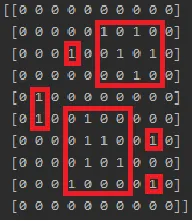二维布尔型数组的子区域
6
- JustANoob
8
不确定你的例子是否符合逻辑。为什么在下面的框中的第一个框不应该包含在更大的框中,因为它们共享一列? - yatu
我犯了一些错误,我添加了相同的数组。它们代表两个不同的示例,红色标记的区域是我想要获取切片的子区域。 - JustANoob
在第一个例子中,不应该有三个区域吗?编辑:我想这取决于您是想要最大尺寸的区域还是最小尺寸的区域。 - user10400458
定义是有效的,并且具有唯一解。我今天不知道自己在想什么,甚至不能给出正确的示例解决方案...马上更新。 - JustANoob
这回答解决了你的问题吗?在像素数组中查找连通组件 那不就是查找连通组件吗? - HansHirse
显示剩余3条评论
2个回答
4
这是连通组件分析,之前已经有人提出并回答了。根据那里的被接受的答案来适应您的需求,可能的解决方案非常简短:
import numpy as np
from scipy.ndimage.measurements import label
def analysis(array):
labeled, _ = label(array, np.ones((3, 3), dtype=np.int))
for i in np.arange(1, np.max(labeled)+1):
pixels = np.array(np.where(labeled == i))
x1 = np.min(pixels[1, :])
x2 = np.max(pixels[1, :])
y1 = np.min(pixels[0, :])
y2 = np.max(pixels[0, :])
print(str(i) + ' | slice: array[' + str(y1) + ':' + str(y2) + ', ' + str(x1) + ':' + str(x2) + ']')
example1 = np.array([
[0, 0, 0, 0, 0, 0, 0, 0, 0, 0],
[0, 0, 0, 0, 1, 0, 0, 0, 0, 0],
[0, 0, 0, 1, 0, 1, 0, 0, 0, 0],
[0, 0, 0, 0, 0, 0, 0, 0, 0, 0],
[0, 0, 0, 0, 0, 0, 1, 0, 0, 0],
[0, 0, 0, 0, 0, 0, 0, 1, 1, 0],
[0, 0, 0, 0, 0, 0, 1, 1, 0, 0],
[0, 0, 0, 0, 0, 0, 0, 0, 0, 0],
[0, 0, 1, 0, 0, 0, 0, 0, 0, 0],
[0, 0, 0, 0, 0, 0, 0, 0, 0, 0]
]).astype(bool)
example2 = np.array([
[0, 0, 0, 0, 0, 0, 0, 0, 0, 0],
[0, 0, 0, 0, 0, 1, 0, 1, 0, 0],
[0, 0, 0, 1, 0, 0, 1, 0, 1, 0],
[0, 0, 0, 0, 0, 0, 0, 1, 0, 0],
[0, 1, 0, 0, 0, 0, 0, 0, 0, 0],
[0, 1, 0, 0, 1, 0, 0, 0, 0, 0],
[0, 0, 0, 0, 1, 1, 0, 0, 1, 0],
[0, 0, 0, 0, 1, 0, 1, 0, 0, 0],
[0, 0, 0, 1, 0, 0, 0, 0, 1, 0],
[0, 0, 0, 0, 0, 0, 0, 0, 0, 0]
]).astype(bool)
for a in [example1, example2]:
print(a, '\n')
analysis(a)
print('\n')
这是输出的结果(不包含示例):
[[...]]
1 | slice: array[1:2, 3:5]
2 | slice: array[4:6, 6:8]
3 | slice: array[8:8, 2:2]
[[...]]
1 | slice: array[1:3, 5:8]
2 | slice: array[2:2, 3:3]
3 | slice: array[4:5, 1:1]
4 | slice: array[5:8, 3:6]
5 | slice: array[6:6, 8:8]
6 | slice: array[8:8, 8:8]
希望能帮到您!
------------------
System information
------------------
Python: 3.8.1
SciPy: 1.4.1
------------------
- HansHirse
1
你可以从图的角度来解决这个问题,将1的坐标作为图元素,8向连接,然后只需找到图中的连通分量。如果数据稀疏,则应该比循环可能的正方形尺寸要快得多。以下是它的工作原理示例:
from itertools import combinations
def find_squares(a):
# Find ones
ones = [(i, j) for i, row in enumerate(a) for j, val in enumerate(row) if val]
# Make graph of connected ones
graph = {a: [] for a in ones}
for a, b in combinations(ones, 2):
if abs(a[0] - b[0]) <= 1 and abs(a[1] - b[1]) <= 1:
graph[a].append(b)
graph[b].append(a)
# Find connected components in graph
components = []
for a, a_neigh in graph.items():
if any(a in c for c in components):
continue
component = {a, *a_neigh}
pending = [*a_neigh]
visited = {a}
while pending:
b = pending.pop()
if b in visited:
continue
visited.add(b)
component.add(b)
b_neigh = graph[b]
component.update(b_neigh)
pending.extend(c for c in b_neigh if c not in visited)
components.append(component)
# Find bounds for each component
bounds = [((min(a[0] for a in c), min(a[1] for a in c)),
(max(a[0] for a in c), max(a[1] for a in c)))
for c in components]
return bounds
a = [[0, 0, 0, 0, 0, 0, 0, 0, 0, 0],
[0, 0, 0, 0, 0, 1, 0, 1, 0, 0],
[0, 0, 0, 1, 0, 0, 1, 0, 1, 0],
[0, 0, 0, 0, 0, 0, 0, 1, 0, 0],
[0, 1, 0, 0, 0, 0, 0, 0, 0, 0],
[0, 1, 0, 0, 1, 0, 0, 0, 0, 0],
[0, 0, 0, 0, 1, 1, 0, 0, 1, 0],
[0, 0, 0, 0, 1, 0, 1, 0, 0, 0],
[0, 0, 0, 1, 0, 0, 0, 0, 1, 0],
[0, 0, 0, 0, 0, 0, 0, 0, 0, 0]]
square_bounds = find_squares(a)
print(*square_bounds, sep='\n')
# ((1, 5), (3, 8))
# ((2, 3), (2, 3))
# ((4, 1), (5, 1))
# ((5, 3), (8, 6))
# ((6, 8), (6, 8))
# ((8, 8), (8, 8))
- jdehesa
网页内容由stack overflow 提供, 点击上面的可以查看英文原文,
原文链接
原文链接

